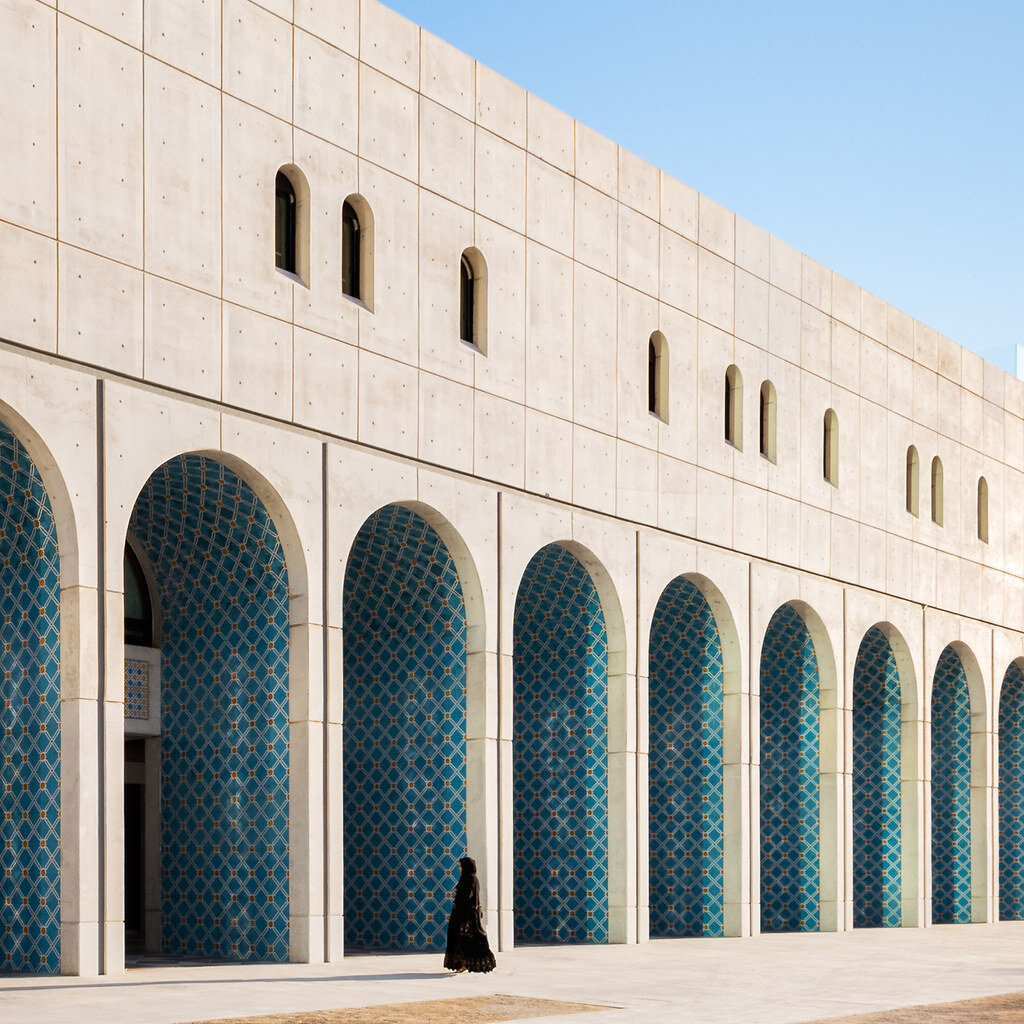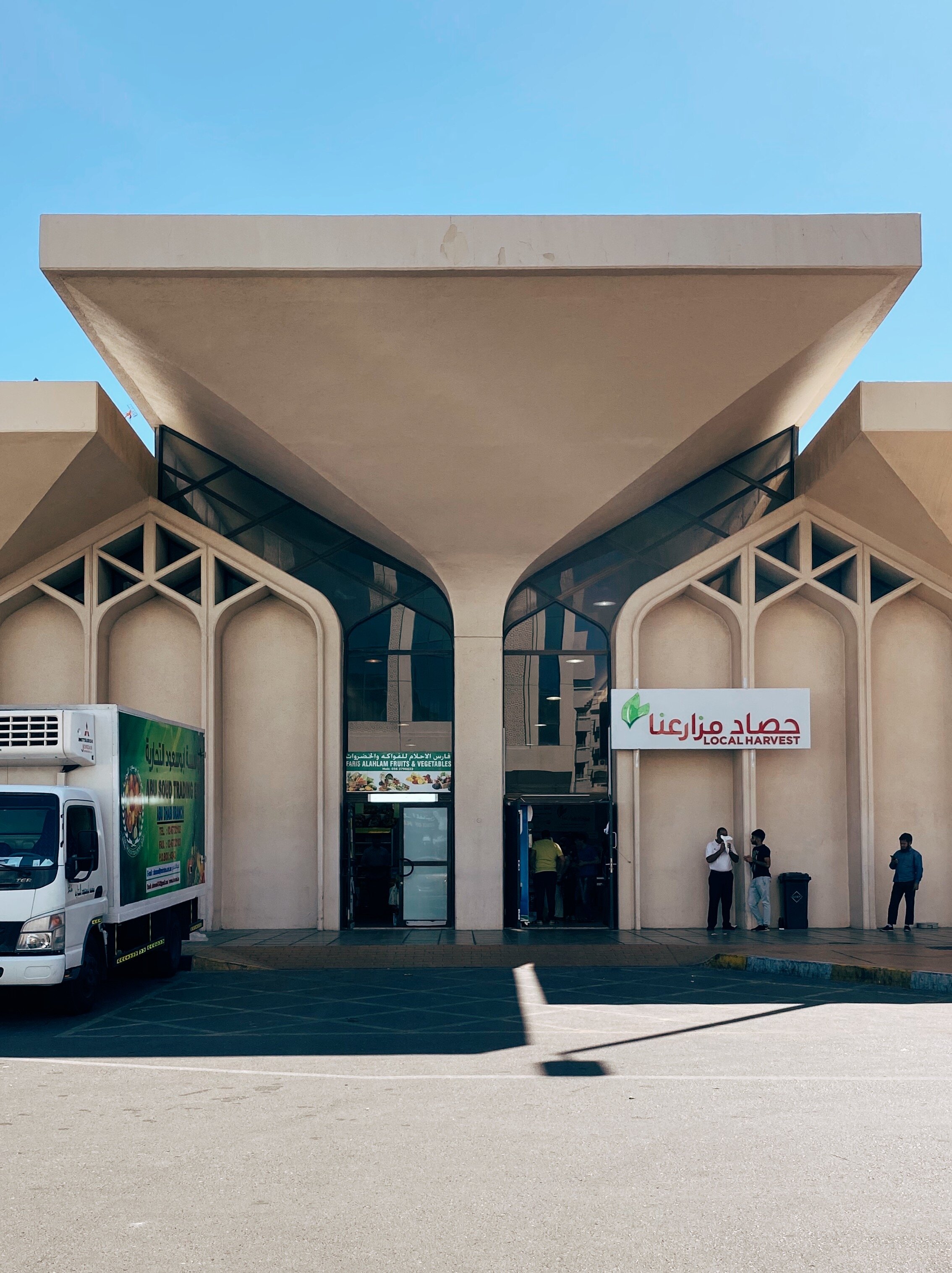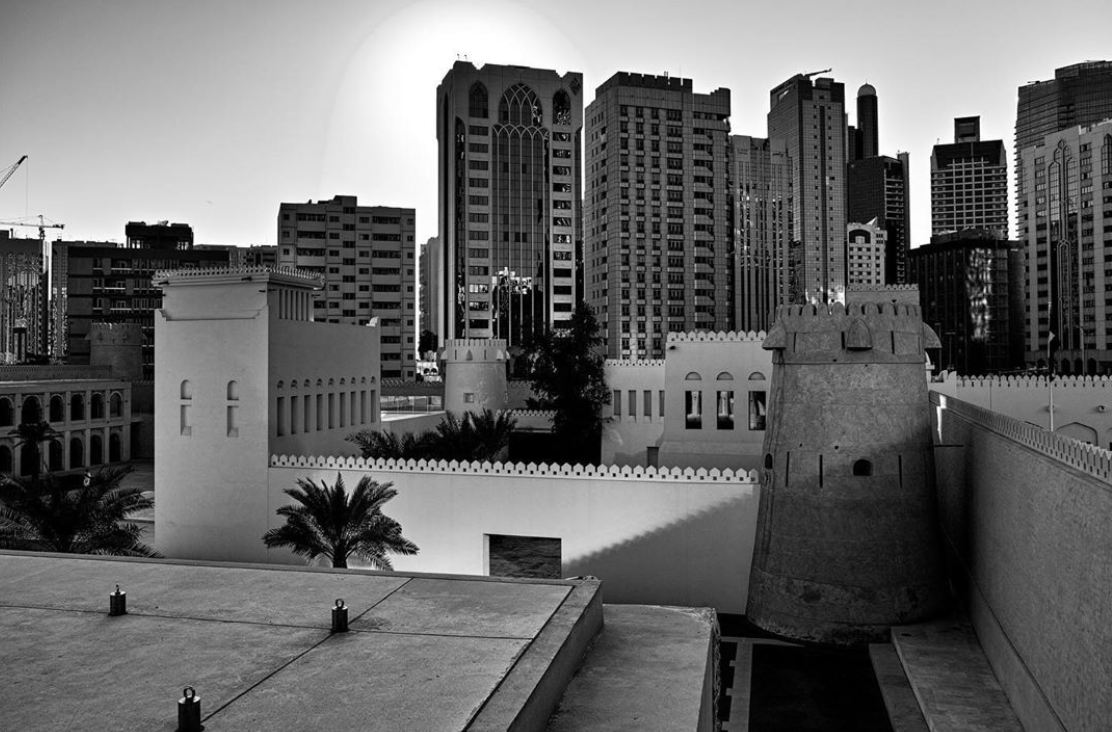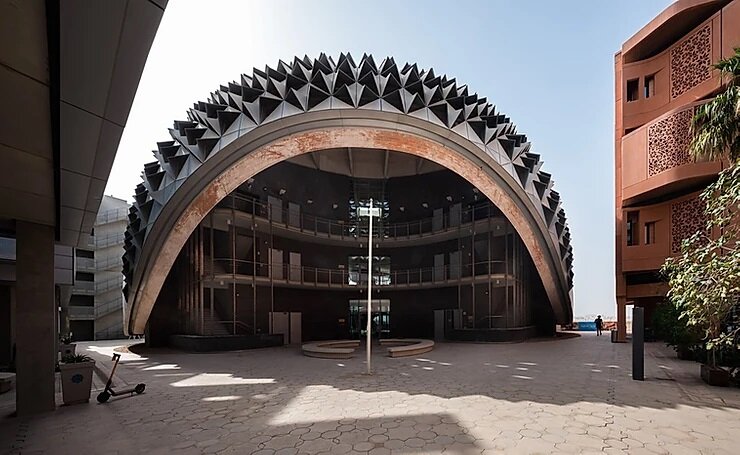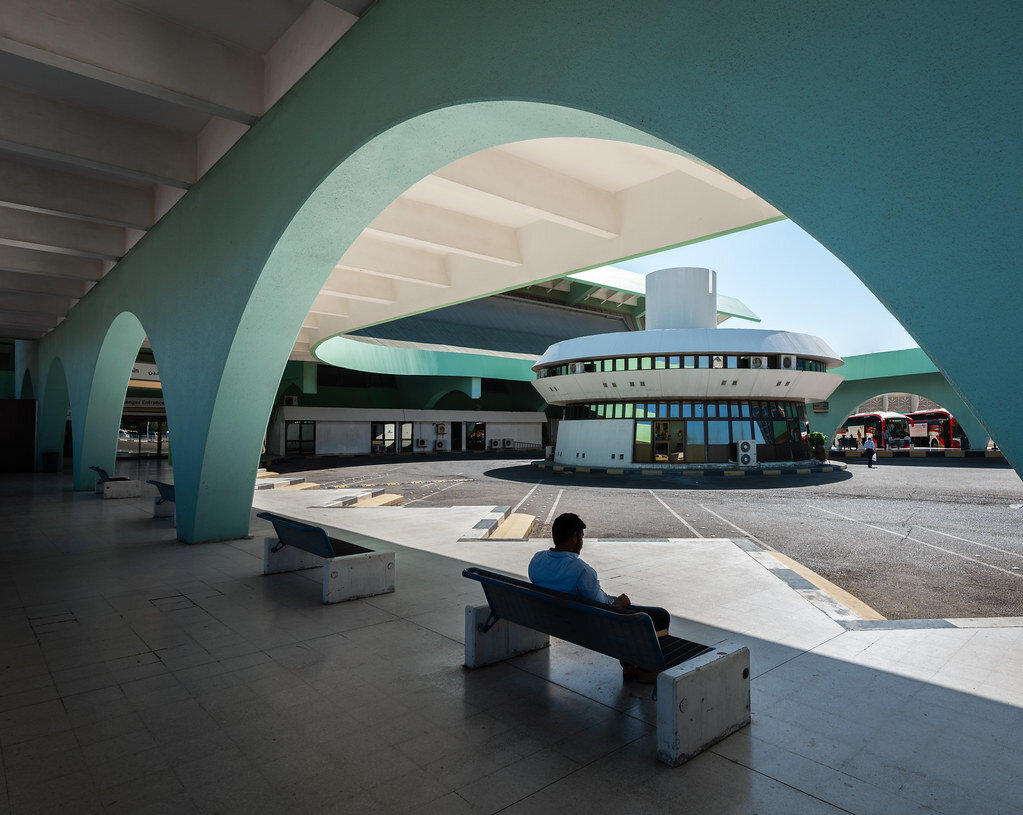Building Identity
Modern Architectural Heritage of the Emirates
Abu Dhabi: A Shared Memory
“One can say that the city itself is the collective memory of its people, and like memory, it is associated with objects and places. The city is the locus of the collective memory.”
— Aldo Rossi
Situated on an island just off the UAE’s northern coast, the city of Abu Dhabi is the capital of the emirate bearing the same name. Until the last decade, most of its population, myself included, lived within a few traffic lights from the city center. We all went to the same Fish Market, bought our video games (of questionable authenticity) from Hamed Center, took turns on the pineapple-shaped slide in Airport Park, watched the censored blockbusters at Eldorado Cinema. Three generations of residents, irrespective of socioeconomic status, shared the spaces in which they ate, shopped, made homes, and spent long nights. These structures served as our landmarks and address system. This was the Abu Dhabi imprinted in my memory.
I left Abu Dhabi for Singapore at the age of eight. Despite visiting in the summers, when I returned in my late teens to a city and country in constant flux, fresh out of university and after years of living abroad, I felt disconnected.
Illustration by Mariam Abbas
With my recent degree in architecture, I needed to put some meaning and context to the city I once knew. I started a personal project to document Abu Dhabi’s architecture and landmarks, and through it hoped to reconnect to a place that had changed so much in just a decade. What did I know of the architecture here? It felt like we were only taught about the historical structures of the region, but nothing mentioned the modernist architecture that surrounded us. This was the drive that led me to many ‘rediscovery’ tours, and reformed those bonds and attachments to the neighborhoods, and structures I remembered and loved.
I began posting my project online and the response was immediate. I made posts of the modern heritage buildings that brought so much nostalgia for the Abu Dhabi of my childhood. Within days my inbox was flooded with messages from followers who felt the same overwhelming nostalgia evoked by these places. Many shared photographs of their old homes or enquired about my memories and stories. There was a collective outpouring of emotional attachment to the city’s modernist architecture and structures. This is when I realized that Abu Dhabi’s urban planning project was a success in an unexpected way; citizens responded strongly to their built environment, and their surroundings became the lifeline to their newly formed identity in the city. A collective memory had been built.
Historically, Abu Dhabi, unlike some of the other Emirates, was not a major port. The island was sparsely dotted with areesh (palm-frond) houses, rough concrete structures, and coral-stone buildings that housed its fishermen and pearl divers, Abu Dhabi’s major trade in the pre-oil era. This provided planners with a blank slate, unburdened by existing and stringent modern infrastructure. Abu Dhabi’s first master plan was drawn up in the 1960s by Halcrow Engineering. As the city continued to grow, the plan was subsequently passed to Aureocon, Takahashi Planners, and later, to Dr. Abdel Rahman Makhlouf. Each built onto the existing plan. As a result, Abu Dhabi today is a series of large arteries on grids running past superblocks, massive neighborhood blocks circled by mixed-use towers that surround a core of residences and essential community functions. This design is still evident today and is what gives Abu Dhabi its unique identity.
Starting in the early 1970s the city began to attract an influx of regional and international architects with the promise of success, access to different materials, and a chance to experiment on new grounds. Movements such as Modernism and Brutalism, which were losing steam elsewhere, found new life in Abu Dhabi, albeit with certain requirements to include Arabic or Islamic regional and vernacular motifs on the buildings.
Residential housing expanded, but most of Abu Dhabi’s land use remained downtown. This changed in 2004, when the passing of the country's founder and ruler, Sheikh Zayed, ushered in a new age of expansion. This point in time saw the demolition of landmarks such as the volcano fountain on the promenade known as the Corniche, as well the closure of the original Cultural Foundation (reopened in 2019). The site for the Central Market, which closed in 2005, was redeveloped into a massive mixed-use project designed by a “starchitect,” the UK-based firm Foster + Partners. These closures had left holes in the heart of the city. All had been extremely important social hubs, and the redevelopment aimed to recapture the city’s public life.
Urban development in Abu Dhabi, which had progressed much more slowly compared to its neighboring Dubai, suddenly was rushed on a massive scale. Nearby islands such as Saadiyat and Yas were designated as new regional centers of culture and entertainment, and many new districts were announced in anticipation of an oncoming population boom. Instead, at the start of the new millennium residents of higher socioeconomic classes suddenly began to move out. These buildings and entire neighborhoods, which had built up distinct personalities over the previous three decades, stagnated, literally and figuratively left behind. As Abu Dhabi staked its claim in the modern world, these areas became a link to the past, a nostalgia that was shared by all. I still interacted with these places, as did everyone else: going to the Fish Market with family, grabbing a ride from the Central Bus Station to Dubai, driving to Hamdan Center on a weekly basis to find the latest videogames.
It may be difficult for newcomers or outsiders to see Abu Dhabi’s modernist buildings as anything but cold, hard monoliths worth studying or preserving, but these places allow the people who lived, worked, and gathered in them to remember the meaning, sense, and emotion of home and community that the buildings provide. Architecture itself cannot be reduced to a façade; architecture is lived in and interacted with. It is as much a part of the city’s identity as its residents are.
It is easy to fall into the trap of looking back at the past through rose-tinted glasses and longing for a time when life seemed simpler, and the chaos of unrestrained development was unimaginable. However, a city cannot be left behind in decay. At the same time, it cannot grow without reforming its identity. A new generation of locals and residents are pushing for those distant memories to be a part of our modern life. Progress is inevitable, but in a place without a platform for architectural archival discourse, at some point the heavy-handed march of progress will need to slow down to allow for a moment of reflection and conversation surrounding our new identity and what role our past has to play in it.
One aspect I always like to raise, when speaking with visitors, is that despite the unforgiving heat that could make for an easy excuse to stay indoors, Abu Dhabi has always been accessible. There are pockets within the city center that allow residents to traverse and interact with each other all year round, building a sense of community that is hard to replicate with the new suburban cities on the mainland. This topic came up multiple times in my discussions with other long-time residents of Abu Dhabi, who remember landmarks that were embedded in quotidian life: a neighborhood bakery, a spice shop, a family-run tailor, or a sweet shop frequented during Ramadan. No matter where they lived, all residents had to walk or drive across the city and interact with people from various socioeconomic backgrounds, which in turn implanted a strong sense of identity and belonging, despite the sprawling reach of Abu Dhabi.
However, the razing of several of Abu Dhabi’s major landmarks has forced residents to reconcile their relationship with their city. The closure of these hubs—the utilitarian Central Market, which, as shoddy as it looked, was very much the heart of the city, and the Cultural Foundation, which served as the cultural epicenter and was shuttered for almost a decade—has been painful for many. They represented hope, metaphors for Abu Dhabi itself, a city of incredible growth that allowed so many residents to seek better lives than the generation before them: symbols of success that was accessible to Emiratis and expatriates alike.
Written by Sultan Al Ramahi
